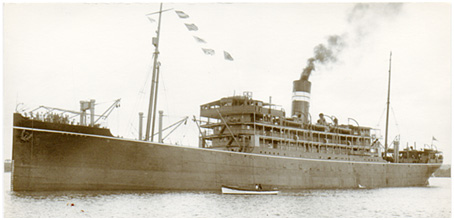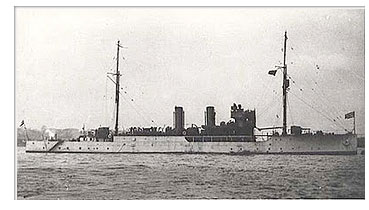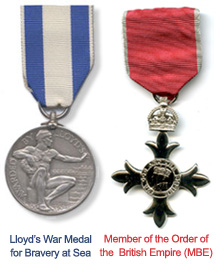FOR ALL THOSE WITH AN INTEREST IN BRITISH INDIA STEAM NAVIGATION (BI)
BI History
Cargo salvage attempts on BI ships MANTOLA and GAIRSOPPA to start in 2012
Silver from Gairsoppa likely to be most valuable ever bullion recovery
AN American salvor is gearing up to recover up to seven million ounces of silver from the BI cargoship Gairsoppa and a much smaller silver cargo from Mantola, both of which sank in the North Atlantic.
On February 8, 1917 passengership Mantola was torpedoed in the Atlantic west of the Scilly Isles by German submarine U-81, with the loss of seven Indian seamen. Then in February 1941 the 8,150 dwt cargoship Gairsoppa sank west of Galway shortly after a torpedo attack by the German submarine U-101. According to Lloyd's of London, 84 of the complement of 85 perished, with the only survivor being the Second Officer Richard Ayres.
Under a salvage agreement the British government has agreed to pay Odyssey Marine 80% of the value of cargo recovered, which could include silver bullion and silver specie. Odyssey expects to start operations at both wrecks in the second quarter of 2012. Gairsoppa lies in approximately 4,700 meters of water, about 300 miles off the coast of Ireland. The hull is upright and lying in an east-west orientation, the torpedo hole being clearly visible. The hatches covering the cargo holds are no longer in place, says Odyssey Marine. Mantola lies in about 2,100 metes of water.
Mantola's sistership MarghaON
Gross Tons
Net Tons
Dwt
137815
8,246
5,190
10,670 tons
Loa
Breadth
Depth
Draught
58.2 ft
35.5 ft
27.9 ft
Passengers
Propulsion
Screws
Indicated Horsepower
Trials speed
Built (delivery)
Builder
Yard noBI M-Class, cargo-passenger
1st: 66 or 81; 2nd 61 or 38
twin triple-exp steam recipr
twin screw
4,050
13.7 knots
June 6, 1916
Barclay, Curle & Co, Glasgow
514Odessey Marine believes Mantola was insured to carry silver worth £110,000 when she sailed from London. That value would indicate the ship might hold as much as 600,000 ounces of silver, based on silver prices in 1917. At current market prices, that much silver would be worth more than $19 million.
Mantola
Mantola was out of London bound for Calcutta with 165 crew and18 passengers. February 8, 1917 found the 8,246 gt ship in the Atlantic and zig-zagging on a northwesterly course 400 miles west of the Scillies (in 49° 55'N, 12° 25'W) when a torpedo struck the hull approximately beneath the bridge.
Merchant Adventurers (F A Hook) recounts that the explosion and column of water it threw up swamped the bridge. The radio room could only get one SOS call transmitted before the main wireless broke down. Inspection inside the ship revealed thant no. 2 hold was already full of water and the main steam pipe probably fractured forcing the engineroom crew, some scalded, on deck. The engines had been reversed by the Chief Engineer Mr McAlister, and later, when way was off the ship, he returned to the engineroom to stop them.
With the engines out of action, the ship sinking by the head and further attack possible at any time, the commander Captain (DJ) James Chivas gave the order for the boats - in which passengers and crew were already assembled - to be lowered. An eaterly wind was blowing giving rise to a high sea, and the temperature was below freezing point. The boat falls were "more or less inflexible" and two of the ropes jumped belaying pins resulting in seven seamen, lifejackets in hand - not worn, being thrown into the sea. They were lost in the icy water before help could reach them.
All the passengers and remaining crew got safely away, leaving the commander on board. At three in the afternoon the Chief Engineer and the Marconi Radio Officer returned on board. Finding the main steam line intact but minor steam piping badly damaged, Mr McAlister managed to restart the dynamo so that further distress calls could be made using the main transmitter. But even as this was happening, U-81 (Capt Raimund Weisbach) surfaced 2.25 miles away and opend fire on Mantola. By 1530 Capt Chivas decided that with no hope of getting up steam in the boilers, the three should abandon ship. They pulled clear in the lifeboat which had been standing by as shelling from the submarine continued; 40 rounds fired with only one hit. The submarine closed to within 200 yards but then suddenly dived and the reason soon became apparent: naval patrol vessel HMS Laburnum (right) was approaching at speed.
When all those adrift had been rescued by the naval vessel, Capt Chivas, with permission of Laburnum's commander, reboarded Mantola with volunteers from his own crew, men of Laburnum and from another torpedoed steamer who had been picked up by the patrol vessel. They found the water already up to the boilers and with no hope of doing anything that night, the party returned to Laburnum. But next morning, in a strong wind with rough sea, Laburnum managed to get a hawser over Mantola's stern and commenced towing the now heavily waterlogged ship. The wind and sea worsened and Mantola settled even more deeply, and at 1130 the hawser parted. With a harbour of refuge 200 miles distant, thus ended the attempt to save the vessel. She was last seen nearly submerged with seas breaking over her decks forward and aft. Passengers and crew were landed at Bantry on Feb 10, 1917.
Gairsoppa
Gairsoppa had a complement of European officers, Calcutta-engaged deck and engineroom crews and Goanese saloon crew under the command of Captain Gerald Hyland. According to Lloyd's of London War Losses, there were also two gunners on board. They were probably Royal Navy personnel. (See crew list below).
The voyage began in Calcutta in December 1940. Gairsoppa was loaded with nearly 7,000 tons of general cargo, pig iron, tea, and an estimated 200 tons of silver. She joined convoy SL 64 in Freetown, Sierra Leone, which departed for Liverpool, UK on January 31, 1941 without a naval escort.
As the convoy reached northern latitudes, the heavily laden Gairsoppa was forced to reduce speed. The weather worsened and on February 14, 1941, the ship, running low on coal and with insufficient fuel to keep station, was forced to leave the convoy and divert to Galway in western Ireland, about 300 miles to the northeast.
The ship was circled by a German four-engine Focke-Wulf Condor aircraft at 0800 on February 16, 1941. That evening at 2230, U-101 (Captain Ernst Mengersen) fired four torpedoes at Gairsoppa, one exploding in the vessel’s no. 2 hold. The impact and explosion of the single torpedo toppled the foremast which carried away the wireless main and emergency aerials, making it impossible for a distress signal to be transmitted. The ship took about 20 minutes to sink.
Bravery during 13-day lifeboat ordeal
According to Valiant Voyaging, two and perhaps three boats were got away in heavy swell and under machine gun fire from the submarine. One boat, in command of the Second Officer Richard Hamilton Ayres, set out with 31 men, eight of them European and 23 Indian. Only Ayres had any skill with boats. It was a dark night and heavy seas were running so they lay-to a sea anchor until dawn when another, waterlogged, boat was found with two Indian seamen on board, who were taken on.
They set sail and steered east under a reefed sail. Much of the fresh water had been lost during launching and there was only enough for two dippers per person a day. After the second day it was found impossible to swallow the boat's biscuits due to dryness of mouth and throat. The Indian seamen occupied the for'ard and midships parts where the canvas boat cover provided some protection from spray. They were issued with blankets, the Europeans giving up theirs to help the Indian men withstand the cold.
Deaths occurred from frostbite from the fourth day on, and there were other deaths from men drinking seawater. By the eighth day the water was all used and the hands and feet of the remaining seven men were badly frostbitten.
Thirteen days after abandoning ship, the Lizard was sighted but by then only three European and four Indian seamen were alive. Seriously weakened, the men endeavoured to bring the boat to the shore in a cove with a narrow entrance, but the wind was blowing directly on shore and was too strong. The boat broached and capsized throwing all the men into the sea, drowning the four Indian seamen. The boat was righted and three Europeans got back on board, only for the boat to capsize again. One of the men swam for the rocks but was washed off and another was unable to maintain a grip on the upturned boat.
* Later promoted and reached the rank of Captain. Subsequently became a BI cargo superintendent, posted to Calcutta, Singaore and Bombay. Retired 1964. Died 1992. Dickie Ayres's father, Captain R A M Ayres, who joined BI in 1898 had earlier commanded Gairsoppa, in 1923. (Lloyd's War Medal was only a WW2 award and given to 500 people).
One survivor - Richard Ayres - was rescued unconscious from the surf by lifeboatmen who had been summoned by children who chanced up the scene as the men were desperately trying to make the beach. The fate of any who made it into the other lifeboats was never known. Richard Ayres* was created Member of Order of the British Empire and awarded Lloyd's War Medal for Bravery at Sea for his courageous efforts to save his shipmates.
Human remains are not expected to be found during work on the wreck due to the depth, age of the shipwreck, circumstances surrounding the sinking, and the area of the ship where work is to be carried out. The silver cargo is located in one of the cargo holds. Odyssey states that in the event human remains are encountered during salvage operations they will be treated with the utmost respect and the UK Department for Transport will be notified.
Three Merchant Navy headstones stand in the graveyard of St Wynwallow at Church Cove, on the Lizard, according to a Western Morning News report of Feb 13, 2010. One marks the resting place of radio officer R F Hampshire. The other two, both Indian sailors, were never identified while Gunner Norman Thomas lies in a civilian grave nearby.
Silver cargo
Research documents, including Lloyd’s War Losses, indicate that Gairsoppa carried a cargo of silver worth £600,000 at the time, which would equate to approximately 7 million ounces of silver. One record clearly indicates that 2,817 silver bars were loaded at one port and another report lists an unconfirmed amount of silver specie. The UK Government's Department of Transport has records that indicate that the goverment paid out an insurance claim for approximately £325,000 of silver bars after the loss of the ship.
The difference between the amount paid out under the War Risk policy and the £600,000 total value of cargo cited by Lloyd's is possibly explained by the uninsured silver lost (£275,000) as having been owned by the government, in which case it may not have appeared on the manifest nor as an insurance claim. The official government record of war loss mentions that the cargo consisted of “silver specie” (which refers to coinage), clearly differentiated from bullion or bars, which was the cargo that was paid out by War Risk insurance.
The ultimate value of the cargo will only be known after recovery and determination of the total amount of silver recovered and how much of it, if any, is in specie.
ON
Gross Tons
Net Tons
Dwt
Ld Displ
141924
5,237
3,227
8,150 tons
11,375 tons
Loa
Lbp
Breadth
Depth
Draught
399.2 ft
52.2 ft
28.5 ft
25.3 ft
Decks and holds
Propulsion
Indicated Horsepower
Trials speed
Built (delivery)
Builder
Yard noStandard wartime B-Type. Three island
Two-deck cargoship with five holds
Steam, 3-cyl triple expansion engine
3,000
11.7 knots
Oct 17, 1919
Palmers' Shipbuilding & Iron Co, Hebburn
894. Laid down as War RoebuckGairoppa Crew List (incomplete) (from Valiant Voyaging, and other sources)
Captain G Hyland Commander G D Cummings Chief Officer R H Ayres* Second Officer C J Morrison Third Offocer J M Woodliffe Cadet R F Hampshire Radio Officer W F Dupuy Purser P E Fyfe Chief Engineer R Lang Second Engineer A P Carmichael Third Engineer H H Odd Fourth Engineer W Lucas Junior Engineer Norman Thomas Gunner [unknown] Gunner * Survived and later awarded MBE and Lloyd's War Medal for Bravery at Sea for his part in attempting to bring men to safety.
Deck Crew (25) Engine Crew (29) Abdool Codoos x Abdul Motaleb Serang Kholill Rahman x Dewan Ali Fireman Serang Abdul Maleck x Mustan Tindal Nozib Ahamode x Mosad Allee First Tindal Khoorshid Meah x Abdul Barrick Cassab Abdool Azis x Eusuph Allee Secomd Tindal Elahi Bux x Abdul Majid Winchman Syed Rahman x Keramat Ali Cassab Abdool Mozid x Mahd. Hossone Seacunny Mohamd Islam x Abdul Majid Lampman Nurul Haq x Edabullah Seacunny Fozore Ali x Hamdoo Mian Donkeyman Khoorshid Meah x Mossoudali Seacunny Soozat Allee x Korone Alle Oilman Abdul Jabbar x Hamid Ali Seacunny Abdul Karim x Bprhanuddin Oilman Syed Ahmad x Ruckbatali Lascar Jalal Ahmad x Asmut Ali Oilman Sikander Badsha x Mohabbatali Lascar Fazal Karim x Asmat Ali Fireman Yazul Moolook x Abdool Allee Lascar Milakat Joma x Anwor Ali Fireman Jabal Hawk x Abdool Mozid Lascar Doola Mian x Eusuph Ali Fireman Salamatullah x Abbass Ali Lascar Abdul Hakim Asmath Ali Fireman Abdul Barrick x Abdul Aziz Lascar Abdul Suttar x Abdul Ghafur Fireman Akel Ali x Asmat Ali Lascar Muni Ahmad x Abdul Majid Fireman Hazibar Rahman x Omer Ali Lascar Nur Ahmad x Abdur Rashid Fireman Mukibul Haque x Abdul Karim Lascar Belait Ali x Fazal Rahman Fireman Wali Mian x Raqbat Ali Lascar Ali Ahmad x Thanda Mian Fireman Ali Ahmad x Anwar Ali Lascar Amin Rahman x Abdool Meah Coal Trimmer Matiur Rahman x Hamid Lascar Raja Meah x Anoo Meah Coal Trimmer Mozid Mian x Abdul Jubbar Lascar Tufail Ahmad x Hasmat Ali Coal Trimmer Mohamad Haroon x Mohamad Meah Lascar Abdul Latif x Ahsanulla Coal Trimmer Murshid Mian x Abdul Barie Bhandary Abdul Karim x Abdus Subhan Coal Trimmer Kishori x Baboo Lall Topass Sherazul Hawk x Ahamode Ali Coal Trimmer Mungal x Sokhi Topass Abdul Rashid x Mohamd Latoo Coal Trimmer Nesar Ahmad x Chunoo Meah Coal Trimmer Maqsul Hosain x Sadaw Ali Coal Trimmer Abdul Ghafur x Musharraf Ali Coal Trimmer Mohamed x Mohorom Coal Trimmer
Saloon Crew (13) A R Pais x M B Pais Butler C Rodrigues x J Rodrigues Chief Cook and Baker C Cardoze x S Cardoze Second Cook L Caldeird x H Caldeird Fourth Cook E C Rodrigues x M Rodrigues Pantryman F De Costa J M De Costa Captain's Boy Sk Kinoo x Lall Chand Chief Engineer's Boy T Rodrigues x F E Rodrigues General Servant J A De Costa x R De Costa General Servant J P Collasco x LV Collasco General Servant T M Fernandes x Augustine Fernandes General Servant J M Costa x F Costa Half General Servant Jetoo x Ruckber Topass Entry from Lloyd's War Losses (Second World War), Feb 16, 1941
Gairsoppa, British, 5237 toms gross, Calcutta for London, with cargo of:
2,600 tons pig iron
1,765 tons tea
2,369 tons general
£600,000 worth silver ingots
Position: About 300 miles SW of Galway Bay. How: submarine
Crew total 83 plus 2 Gunners. 84 lost. 2nd Officer was sole survivor

(There are conflicting reports of the actual date of the submarine attack and loss. VV and Lloyd's put it at Feb 16, while Odyssey Marine has Feb 17).
Other history pages: Timeline | Companies | Routes | BI News | Mercantile Empire | BI/P&O Merger document | Gairsoppa & Mantola | Dara wreck | Rohilla disaster | Calabria | Abhona trials | E Africa Shipwrecks | Today in History




